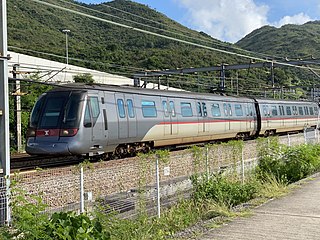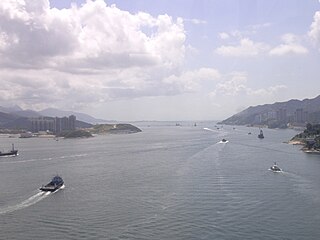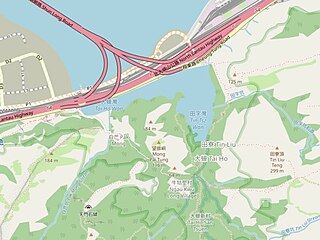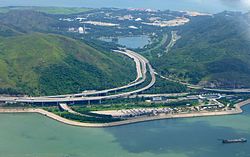
Tsing Ma Bridge is a bridge in Hong Kong. It is the world's 16th-longest span suspension bridge, and was the second longest at time of completion. The bridge was named after the two islands it connects, namely Tsing Yi and Ma Wan. It has two decks and carries both road and rail traffic, which also makes it the largest suspension bridge of this type. The bridge has a main span of 1,377 metres (4,518 ft) and a height of 206 metres (676 ft). The span is the longest of all bridges in the world carrying rail traffic.

Lantau Island is the largest island in Hong Kong, located West of Hong Kong Island and the Kowloon Peninsula, and is part of the New Territories. Administratively, most of Lantau Island is part of the Islands District of Hong Kong. A small northeastern portion of the island is located in the Tsuen Wan District.

The Islands District is one of the 18 districts of Hong Kong. It is part of the New Territories. It had a population of 170,900 in 2018.

Tung Chung, meaning "eastern stream", is an area on the northwestern coast of Lantau Island, Hong Kong. One of the most recent new towns, it was formerly a rural fishing village beside Tung Chung Bay, and along the delta and lower courses of Tung Chung River and Ma Wan Chung in the north-western coast of Lantau Island. The area was once an important defence stronghold against pirates and foreign military during the Ming and the Qing dynasties.

The Tung Chung line is one of the ten lines of the MTR system in Hong Kong, linking the town of Tung Chung with central Hong Kong. A part of the Tung Chung line was built along with the Kap Shui Mun Bridge and the Tsing Ma Bridge. The line currently travels through eight stations in 31 minutes along its route. The line is coloured orange on the map.

The Lantau Link, formerly known as the Lantau Fixed Crossing, is a roadway in Hong Kong forming part of Route 8 linking Lantau Island to Tsing Yi, from which other roads lead to the urban areas of Kowloon and the rest of the New Territories. Part of the Airport Core Programme centred on the new Hong Kong International Airport on Lantau, the link was officially opened on 27 April 1997, and it opened to traffic on 22 May the same year.

Chek Lap Kok is an island in the western waters of Hong Kong's New Territories. Unlike the smaller Lam Chau, it was only partially leveled when it was assimilated via land reclamation into the 12.48 square kilometres (4.82 sq mi) island for the current Hong Kong International Airport, which opened for commercial aviation in 1998. The airport is popularly referred to as Chek Lap Kok Airport to distinguish it from the former Hong Kong International Airport, now commonly known as Kai Tak Airport (啟德機場).

Route 8 of Hong Kong is a dual 3-lane carriageway motorway that links Lantau Island, Tsing Yi Island, Cheung Sha Wan in West Kowloon, and Sha Tin in the southeast New Territories of Hong Kong. It is a combination of many sections.

The Airport Core Programme was a series of infrastructure projects centred on the new Hong Kong International Airport during the early 1990s. The programme was part of the Port and Airport Development Strategy, commonly known as the Rose Garden Project.

Route 3 is a series of expressways in Hong Kong that runs from Sai Ying Pun on Hong Kong Island to Yuen Long in the New Territories, linking West Kowloon, Kwai Chung and Tsing Yi. It was built as part of the Airport Core Programme to provide access to Hong Kong International Airport from the city, and to relieve congestion in the New Territories. The Western Harbour Crossing and Tai Lam Tunnel that form part of the route are tollways.

Urmston Road is a broad body of water between Lantau Island and Tuen Mun in Hong Kong. It forms an inshore passage between the northwest end of Victoria Harbour and the mouth of the Pearl River. At its eastern end it connects to the Western Working Anchorage through the Ma Wan Channel and the narrower Kap Shui Mun channel to the west of Ma Wan.

The Hong Kong Strategic Route and Exit Number System is a system adopted by the Transport Department of the Hong Kong Government to organise the major roads in the territory into routes 1 to 10 for the convenience of drivers. When the system was implemented in 2004, the government promoted it with a major public campaign, including the slogan "Remember the Numbers; Make Driving Easier".

Ma Wan Viaduct is a viaduct built over Ma Wan, an island in Hong Kong. The viaduct connects the Tsing Ma Bridge and Kap Shui Mun Bridge with an exit to Ma Wan Road, and is part of the Lantau Link and Route 8. It was opened on 22 May 1997 and was built to provide access to the Hong Kong International Airport as part of the Airport Core Programme.

Siu Ho Wan is a bay on the north shore of Lantau Island in Hong Kong. The bay has been largely reclaimed for bus depots. The Airport Express, Tung Chung line of the MTR and the North Lantau Highway run across the reclamation of the bay. The Siu Ho Wan MTR depot lies on the reclaimed shore between Ngau Kok Wan and is currently used by Airport Express, Tung Chung line and Disneyland Resort line.

Tai Ho Wan or Tai Ho Bay is a bay on the north shore of Lantau Island in the New Territories of Hong Kong. It is located west of Siu Ho Wan, and northeast of Tung Chung and Kei Tau Kok. The surrounding land was originally planned to be part of the North Lantau New Town scope, but there is a current slowdown in its plans because of the lack in population growth and environmental groups opposed to the next in abeyance.

The Tuen Mun–Chek Lap Kok Link is a road project in the New Territories, Hong Kong. It comprises two elements: the "Northern Connection" and the "Southern Connection". The Northern Connection comprises an undersea tunnel crossing the Urmston Road, linking Tuen Mun to the "Boundary Crossing Facilities" (BCF), an artificial peninsula connected to Hong Kong International Airport. The Southern Connection, officially named Shun Long Road, comprises viaducts linking the BCF to North Lantau Highway on Lantau Island.



















